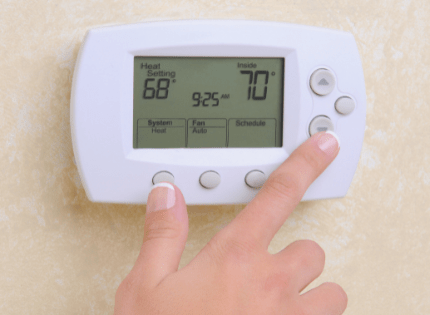If you own a commercial building in Chicago, you know that your utility bills and maintenance costs for your HVAC system have the tendency to cut significantly into your profit.
“One of the most critical components in a property is the HVAC system. A well maintained HVAC system allows for optimal temperature control and comfort for your Tenants,” Aida Chavarria, Cawley Commercial Real Estate Senior Property Manager, said.
Keeping your building comfortable in the below-freezing winters and the 90-degree days in the summer puts a lot of strain on your wallet and your equipment.
Below, heating and cooling experts from Blue National HVAC will discuss the top five ways to reduce your energy costs as well as your ongoing cost of system maintenance.
1. Install Programmable Thermostats
If you don’t already have programmable thermostats for your HVAC zones installed in your building, you should definitely start there! Having programmable thermostats is one of the best ways to keep your utility bills at a minimum, as they allow you to conserve energy by reducing cooling or heating an area of the building that is unoccupied for a portion of the day or has occupants who are comfortable in more reasonable temperatures.
You can program your HVAC system to shut off entirely at night during the summer or to decrease the indoor temperature to 60 degrees or so in the winter to prevent freezing and conserve energy. Just remember to set your system to turn back on and up to a comfortable temperature about an hour or two before occupants arrive in the morning.

2. Don’t Neglect Routine Maintenance
One of the biggest reasons building owners overpay for their utility bills and maintenance is because they don’t service their systems unless there’s an issue. Ongoing HVAC maintenance in Chicago is crucial because the erratic and sometimes extreme climate puts a lot of wear and tear on your equipment, and year-round use means your systems will be more likely to break down.
Scheduling preventative maintenance keeps your HVAC system running smoothly and efficiently, which will help reduce your energy bills. Minor issues will also be caught before they become significant and cause your systems to go down, so you’re likely to save money on more extensive repairs as well.
3. Install an Economizer
An economizer is a piece of equipment that senses the difference between indoor air and outdoor air. If the air outside is closer to your desired indoor temperature than the actual indoor temperature, it opens dampers to the outside and uses fresh air to cool or heat your building. Economizers can produce significant savings on your energy bills, and they also help reduce strain on your other HVAC equipment.
Economizers are a requirement in most commercial buildings in the area now, but the old architecture in Chicago means your building was likely constructed and fitted with an HVAC system long before economizers were made mandatory. If you don’t have one in your building, you should consider updating a bit by getting one installed.
4. Get Your Ductwork Sealed
Anyone living in Chicago is painfully familiar with the constant below-freezing temperatures from November through March and the uncomfortably hot average temps over 80 from June to August. The large temperature swings in the Chicago area mean you’ll likely be relying on your commercial HVAC system year-round.
Having your ductwork sealed will help minimize leakage of conditioned air to your attic or the outside of your building. This will make your building more comfortable, can significantly reduce your energy costs, and will produce less of a strain on your equipment, making it last longer.
5. Upgrade Your HVAC System
As a last resort, you may want to upgrade your HVAC system entirely. Most commercial buildings in Chicago are more than 50 years old, and some built in the late 1800s and early 1900s are still standing.
As business and population in the Windy City grow, additions to buildings and changes to floor plans are becoming more and more common. Changes to your aging building affect the efficiency of your HVAC system, and the likelihood of outdated equipment is high if your building wasn’t built in the last decade or so.
Heating and cooling equipment becomes more efficient year after year, so if you haven’t gotten your system updated in the last ten years, you should consider doing so.
This is especially true if you’ve since made any changes to the interior of your building or have added to the existing structure.

Wrapping Up
Owning commercial property anywhere is generally a good investment, but it’s always wise to limit your overhead to maximize the profit you see from your property.
This couldn’t be more true of buildings in Chicago. With extreme temperatures in the summer and winter and constant strain on a potentially aged Chicago building, it’s crucial to take steps to reduce your energy usage and the wear and tear on your heating and cooling equipment.
Install programmable thermostats, get routine maintenance scheduled, add an economizer, and have a professional seal your ducts, and you could be looking at reduced energy bills and several more years of life from your setup.
If you have an older building or a system that is more than ten years old, you might want to consider upgrading to maximize comfort and savings on utility bills.



